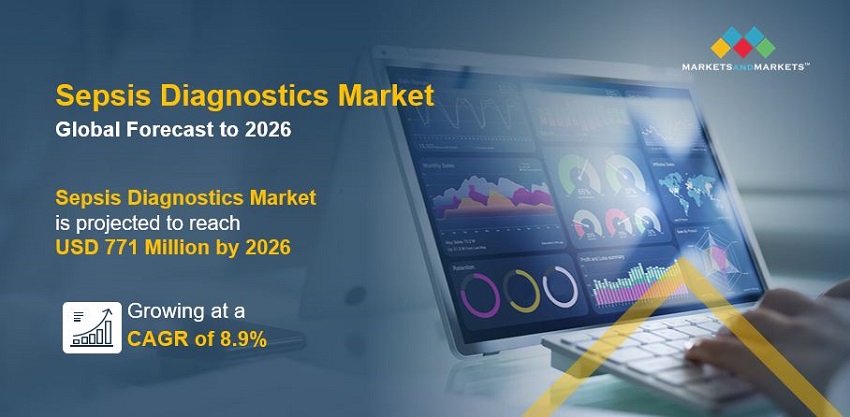Sepsis Diagnostics Market is projected to reach $771 million, Globally, by 2026 at 8.9% CAGR, Says MarketsandMarkets™

According to market research report, "Sepsis Diagnostics Market Size, Growth by Technology (Microbiology, PCR, Sequencing, Biomarkers), Product (Reagents, Assay, Instruments, Software), Test Type (Lab, POC), Pathogen (Bacterial, Viral, Fungal), End User (Hospital, Pathology Lab) - Global Forecast to 2026", is projected to reach USD 771 million by 2026, at a CAGR of 8.9%.

Download PDF Brochure: https://www.marketsandmarkets.com/pdfdownloadNew.asp?id=92673155
Browse and in-depth TOC on "Sepsis Diagnostics Market"
201- Tables
47- Figures
236- Pages
Based on technology, the biomarkers segment is expected to register the highest growth rate during the forecast period
Based on technology, the global sepsis diagnostics market is segmented into microbiology, molecular diagnostics, immunoassay, flow cytometry, microfluidics, and biomarkers. The biomarkers segment is expected to grow at the highest CAGR during the forecast period. The growth of this segment can be attributed to various advantages offered by this technique in the diagnosis of sepsis and the growing need for early disease diagnosis.
North America accounted for the largest share of the sepsis diagnostics market
Geographically, the sepsis diagnostic market is segmented into North America, Europe, Asia Pacific, and the Rest of the World. North America is estimated to account for the largest share of the market. This can be attributed to the growing prevalence of sepsis, increasing incidence of hospital-acquired infections, fast adoption of high-end sepsis diagnostics devices, and rising government support for sepsis-related research. Hospital-acquired infections (HAIs), also known as nosocomial infections, are a major cause of morbidity and mortality worldwide. The most common hospital-acquired infections (HAIs) are urinary tract infections, pneumonia, and sepsis. HAIs can lead to sepsis in immunocompromised patients, geriatric patients, and patients suffering from chronic illnesses.
In the US, the incidence of sepsis among hospitalized patients is rising by 8.7% per year. It is estimated that more than 1,000,000 cases of sepsis among hospitalised patients occur each year in the United States (Source: CDC, 2018). With the rapid increase in HAIs worldwide, the demand for sepsis diagnostic products is also expected to rise in the coming years.
Speak to Analyst @ https://www.marketsandmarkets.com/speaktoanalystNew.asp?id=92673155
Geographical Growth Scenario:
Geographically, the sepsis diagnostic market is segmented into North America, Europe, Asia Pacific, and the Rest of the World. North America is estimated to account for the largest share of the market. This can be attributed to the growing prevalence of sepsis, increasing incidence of hospital-acquired infections, fast adoption of high-end sepsis diagnostics devices, and rising government support for sepsis-related research.
Key Players:
Some of the prominent players in the sepsis diagnostics market are bioMérieux (France), Becton Dickinson Company (US), Danaher (US), Abbott Laboratories (US), and Roche Diagnostics (Switzerland). Other players include T2 Biosystems (US), Luminex (US), Thermo Fisher Scientific (US), Bruker (US), EKF Diagnostics (UK), Immunexpress (Australia), Response Biomedical (Canada), Axis-Shield Diagnostics (UK), among others.
- Art
- Causes
- Crafts
- Dance
- Drinks
- Film
- Fitness
- Food
- Spellen
- Gardening
- Health
- Home
- Literature
- Music
- Networking
- Other
- Party
- Religion
- Shopping
- Sports
- Theater
- Wellness
- IT, Cloud, Software and Technology


